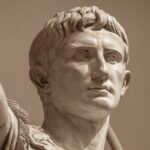We explain what the Roman Empire was, its characteristics and the dynasties that reigned. In addition, the fall of the empire and its cultural features.
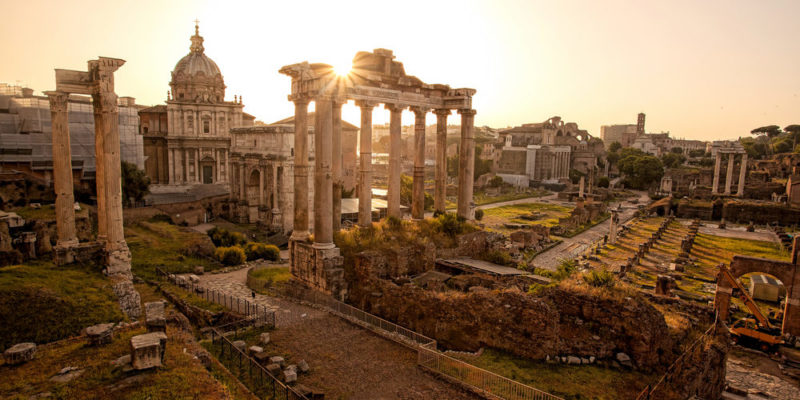
What was the Roman Empire?
The Roman Empire was The last of the three stages of the history of Roman civilization. The Romans were a civilization of the old age that was established in the Italian Peninsula and conquered much of Europe, North Africa and the Near East. Although its history began seven centuries before, the imperial stage covered from 27 a. C. until 476 d. C., in the West and 1453 d. C. in the East.
This period was considered as “the golden centuries” by classic historiansbecause Rome consecrated itself as a dominant power over the Mediterranean Sea, North Africa, west of Asia and Southwest of Europe.
The Roman Empire It was characterized by an autocratic government in which the administrative, political, military powers were in the hands of an emperor. Throughout imperial history, different dynasties inherited the succession of government and imposed their style in Roman society.
See also: Roman monarchy
Characteristics of the Roman Empire
The main characteristics of the Roman Empire were:
- Existed between 27 a. C. and 476 d. C. in the West, and in the East lasts until 1453 d. C.
- It organized around the figure of the emperor.
- He had four imperial dynasties during the period of the high empire, and three others during the period of the low empire.
- His society was differentiated by access to wealth to achieve power positions.
- He had a dynamic economy, organized around the administration of taxes and the promotion of trade.
- He developed an artistic, literary and architectural culture that remained a reference for the rest of the Western societies.
Geographical location of the Roman Empire
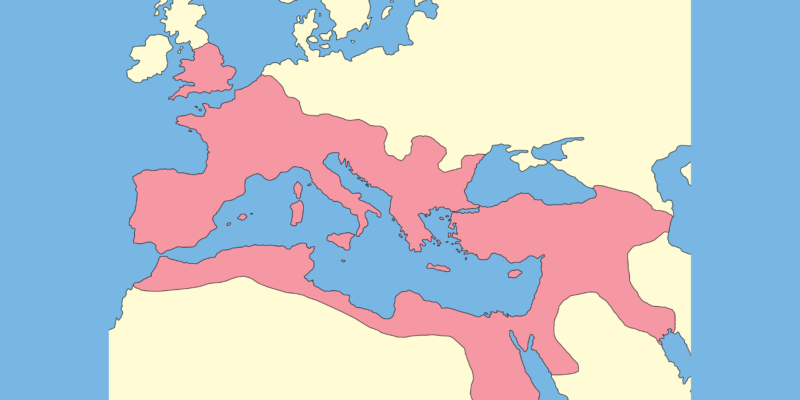
Roman civilization occupied the European italic peninsula. With the conquests, the Roman Empire came to control almost the entire European continent, the Mediterranean coast of Africa and the inhabited areas of the Near East.
The northern border was marked by the Rin and Danube European riversthe western border through the Atlantic Ocean, the Eastern border by the Asian red and black seas and the southern border through the African Sahara desert.
Origin and History of the Roman Empire
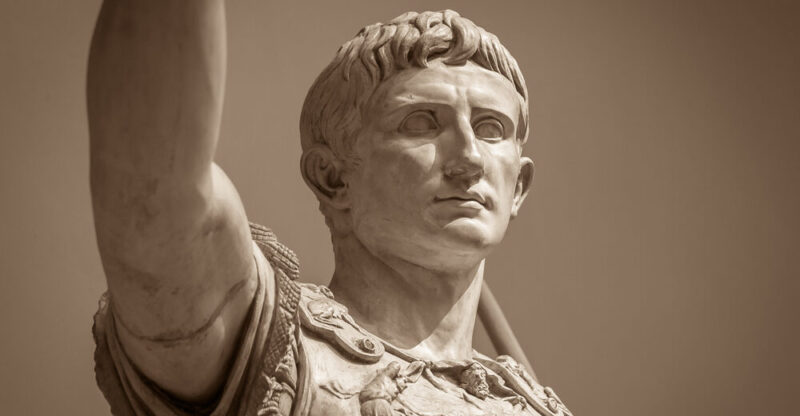
The history of Roman civilization It is divided into three major periods which correspond to its form of government: monarchical period (753-509 a. C.), Republican period (509-27 a. C.) and imperial period (27 BC.-457 d. C./1453 d. C.).
Background
During the republican period, the Romans They carried out a series of conquest campaigns and imposed themselves as a power in the Mediterranean region. This period was marked by a senatorial government. In the 1st century a. C., internal conflicts and disputes to be able to lead to a political crisis, in which the generals of the Roman army were obtaining greater power, to the detriment of the senatorial aristocracy.
Julio Cesar was the first general who managed to impose himself on senators and demand extraordinary powers: he was appointed perpetual dictator, incorporated many of his supporters in the Senate and abolished some magistrates (officials of officials). He took care of being recognized throughout all the territories of the Romans and sought to have the support of the population. To do this, he organized games and celebrations in his honor, built statues and coined coins with his effigy. In 44 a. C., a conspiracy of senators killed him.
After his death, A triumvirate formed that ruled with the SenateIntegrated by Lépido, Marco Antonio and Octavio. In 27 a. C., Octavio managed to impose himself on the other members, submitted the Senate and was proclaimed Princeps (“First citizen of the State” in Latin).
Stages of the Roman Empire

- High Empire. The first imperial stage was characterized by the strength of institutions, political stability and a balance of power between the emperor and the different foci of power in the great Roman territory. The various emperors managed to pacify, control and administer the distant imperial provinces, reach diplomatic agreements with neighboring states and ensure borders. Also, during this stage, the emperors managed to reduce internal conflicts and maintain the support of the popular sectors.
- Under empire. From the third century d. C., Rome began to cross several conflicts: rebellions in different regions of the empire, invasions of other peoples at the borders and clashes between the different military leaders due to the positions of power. This constant war ruined the crops and consumed the economy. At the end of the third century d. C., the Diocletian emperor promoted an imperial division in two regions: one oriental and one western. In turn, to end the succession problems, each region would be governed by a august and for a cease. While there were several moments of reunification, the imperial division ended up imposing. Towards the end of the fourth century d. C., the Roman Empire of the West began a definitive decline process. On the other hand, the Roman Empire of the East, with capital in Constantinople, stabilized and enriched.
Fall of the Roman Empire
The last emperor of Rome was Romulo Augustowhich ruled from 475 to 476 with only 15 years of age. Paradoxically, he carried the same name as the founder of Rome, Romulo, and that the first emperor, Augustus. He was captured and executed by Odoacro, head of the Germanic tribe of Héroulo origin, who assumed power by force and ended the period of the Roman Empire of the West.
The Roman Empire of the East continued to be a power until, in 1453, His capital Constantinople was conquered by the Ottoman Empire.
Roman Empire dynasties
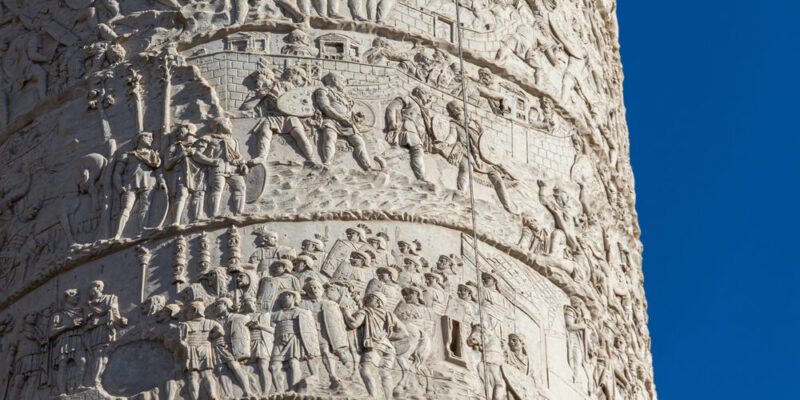
In the Roman Empire, four great dynasties ruled that formed the period called the High Empire. These were:
Julio-Claudio dynasty (27 BC.-68 AD)
- Octavio Augusto. The first emperor of Rome was Octavio Augusto and had the louder reign, from 27 a. C. at 14 d. C., in which he managed to expand the empire. His assumption represented the end of the Republic and the beginning of an era of peace, although the border wars were constant.
- Tiberius. He ruled from 14 to 37 d. C. It was characterized by reforming military law and creating new heavy infantry bodies. However, his reign declined by chaos and wars.
- Caligula. He was the third emperor and ruled between 37 and 41 d. C. Roman stories about Caligula focused more on their sick personality, unprecedented cruelty, than in their performance as an emperor. He died stabbed during a play.
- Claudio. He ruled from 41 to 54 d. C. turned out to be a great ruling and military strategist, loved by the Roman people after developing good government administration. There are suspicions around his death: it is not known whether it was due to a disease or was poisoned.
- Nero. He was Claudio’s adopted son. With only 17 years he assumed the reign and ruled from 54 to 68 d. C.
Flavia dynasty (69-96 d. C.)
- Vespasian. After Nero’s death, and after several civil wars, Commander Vespasian took power from 69 to 79 d. C. was the precursor that gave rise to a caste of flavic emperors that was the shortest of all dynasties.
- Titus. He ruled from 79 to 81 d. C. and stood out for the development of infrastructure of public buildings, such as the Flavio amphitheater known as Colosseum. He died after two years of reign.
- Domician. Tito’s brother ruled from 81 to 96 and was one of the emperors most hated by the Roman people, considered a cruel and paranoid tyrant.
Nerva-Antonino dynasty (96-192 AD)
It was the period that represented the peak of Rome, with the largest extent of territory and known as “the Golden Age of Rome.” Its rulers stood out for the moderate use of power.
- Nerva. It was the precursor of this dynasty. He ruled from 96 to 98 d. C. and was considered wise and moderate in his actions.
- Trajan. He ruled from 98 to 117 and was characterized by promoting development in the city and building numerous buildings and monuments, such as the Trajano forum and the Trajan market.
- Adriano. Reigned from 117 to 138 d. C. and stood out for promoting numerous reforms in the fiscal system, in slave laws and in the duration of convictions. Unlike all other emperors, it carried out few military operations.
- Antonino Pio. Reigned from 138 to 161 d. C. And it was a peaceful government, except for a military disturbance against the British Brigants, a fact that prompted him to build Antonio’s wall.
- Lucius Verus. Reigned from 161 to 169 d. C. along with Marco Aurelio, which meant the first of the governments with multiple emperors simultaneously. The causes of his death are confusing; Some historians consider that he was poisoned and others claim that he died because of an epidemic that ravaged Roman society at the time.
- Marco Aurelio. He ruled from 161 to 169 d. C. together with Lucius Verus, in a period that was characterized by the constant wars. Then he ruled alone, from 169 to 177 d. C. was an outstanding commander and lived a modest life. Implemented reforms in administration and civil law. It was the last of the “five good emperors of Rome.” From 177 to 180 d. C. ruled together with comfortable.
- Comfortable. From 180 to 192 d. C. reigned alone. He was very criticized due to the cruelty of his actions and considered a tyrant by his contemporaries and successors. He was killed as part of a conspiracy. At his death, a political crisis known as “the year of the five emperors” was unleashed.
Severana dynasty (193-235 AD)
- Septimio Severo. After the murder of comfortable, who had no heirs, Seventimio Severo assumed by force amid numerous civil wars. He ruled from 193 to 198 d. C., in an attempt to continue with the old dynasty. Then, he reigned with Caracalla from 198 to 209 d. C. and, in addition, with Geta from 209 to 211 d. C.
- Caracalla. He ruled together with Severana from 211 to 217 d. C. and stood out for granting Roman citizenship to all the inhabitants of the Empire. However, it was a despotic and cruel emperor.
- Macrino. He ruled between 217 and 218 d. C. In his past, Emperor Caracalla served in civil matters. He conspired against his death and assumed imperial power. The following year, he died at the hands of rebel troops that supported the rise of another military chief as an emperor.
- Heliogála. It prevailed between 218 and 222 d. C. His government was characterized by attempts to establish abrupt changes in Roman religious and ceremonial tradition. He had a negative reputation for his social behaviors and was criticized for wanting to implement the undefeated sun cult (a solar divinity). He died killed by a conspiracy, which put his cousin in power.
- Alejandro Severo. He was the last emperor of the Dynasty of the Severos. He ruled from 222 d. C. until his murder in 235 d. C. At his death, the period known as “Crisis of the third century” of Roman history began.
In addition, three other smaller dynasties that formed the period called the low empire ruled. These were:
- Constantinian dynasty (337-388 AD). His emperors were: Constancio I, Galerio and Severo II, Constantino I El Grande, Licino, Máximo Daya, Valerio Valente, Martiniano, Constantino II, Constantium II, Constant, Magnencio, Vetranio, Nepociano, Juliano El Apóstata and Jovian.
- Valentinian dynasty (379-395). His emperors were: Valentinian I, Flavio Graciano, Valentinian II and Máximo.
- Teodosian dynasty (395-476). His emperors were: Teodosio I, Arcadio, Honorio, Constancio III, Joannes, Valentinian III, Petronio Máximo, Avito, Mayoriano, Libyan Severe, Antemio, Olibrio, Glycerio, Julio Nepote and Romulo Augusto.
Roman Empire Economy

The economy of the Roman Empire It was based on agriculture, with the work of peasants and slavesand the trade that intensified as the Empire expanded its territories.
The economy of the Roman Empire was based on the management of the varied resources that could be obtained in its wide territory. Through the tax and trade system, the Romans They took advantage of the different ecological regions to obtain a wide variety of resources: Wheat, wine, oil, iron, gold, silver, tin, copper, horses and other shooting animals, slaves, ceramics, marble, wood, precious stones and luxury handmade objects, such as perfumes, fabrics and skins.
The Mediterranean Sea was the axis of trade and the transfer of goods. His most important ports were Ostia (in the vicinity of Rome, Italic Peninsula), Marseille (Gaul), Gades (Hispania), Carthage (Numidia), Lepis (Cyrenaica), Alexandria (Egypt), Antioch (Syria) and Byzantium (Asia Minor/Grecia). From those ports there were land routes to the interior of the provinces. In addition, from Antioch it entered the Silk route that reached China and, from Alexandria, to the route of spices that India reached.
During the imperial period, Various gold, silver, bronze and copper coins were used. Some regions had their own coins for local exchanges.
In addition, the Romans They built an extensive road network that, radially, converged in the city of Rome. Its construction was planned and studied, so that the roads last and do not cross flood or swampy areas. These roads served both for the transport of goods and trade, and for the transfer of imperial troops.
Society in the Roman Empire
Roman society was marked by classes differentiation around wealth and family origin. Originally, the Roman people were divided between patricians (noble families) and commoners (common population). In the preimperial era, after the struggles of the plebeians for the elimination of privileges, this distinction was losing relevance. Instead, personal wealth became an increasingly important factor to achieve a privileged social position.
The greatest social differentiation had to do with the areas of the civitas (Latin word for “citizenship”): the urban and rural areas. Urban life was dedicated to commercial, artisanal and government activities. Rural life was organized around the urban nucleus and provided it with raw materials. The majority of the population lived from the cultivation of their small properties, which worked together with their family.
Roman society was a slave. Slaves were mainly bought to work in the lands of the great owners. They could achieve the manumission (liberation) and access the condition of Libertos.
Culture in the Roman Empire
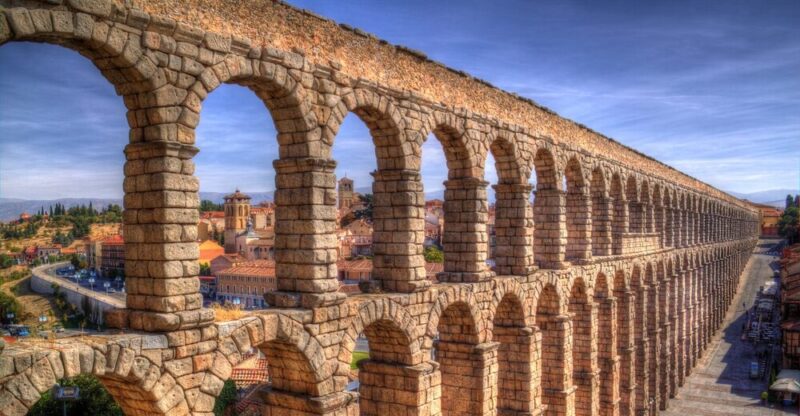
During the imperial period, Roman culture stood out in various disciplines such as architecture, literature, plastic arts and philosophy. The knowledge and styles developed at this time became a reference for artists and scholars of the entire posterior western society.
- Architecture. The emperors sent to build great works throughout the imperial history: buildings, monuments, aqueducts, sewage networks, roads, public bathrooms, amphitheaters, triumph arches, etc. Roman constructions were oriented to civil and military use and were carried out with slave labor, but designed by professional architects and engineers. They used stone, wood and marble, to those who linked with a mixture of concrete -based mortar.
- Philosophy. The development of philosophical studies was characteristic of imperial Roman culture. The Romans took two important philosophical currents from the Greeks: stoicism and epicureanism. Stoic philosophers, such as Seneca, Epicteto and Marco Aurelio, used reasoning as a search for inner peace and virtue. On the other hand, for Epicureans the objective of philosophy was the search for happiness.
- Literature. The great Roman classic poets, such as Virgil, Ovid and Horacio, lived the end of the Republican period and imperial construction. The Roman nobles commissioned the composition of works to Latin writers and kept them economically. In addition to the literary works, in the development of historical studies, Tito Livio, Suetonio and Tacitus stood out, which reported the events of their time.
Contributions of the Roman Empire
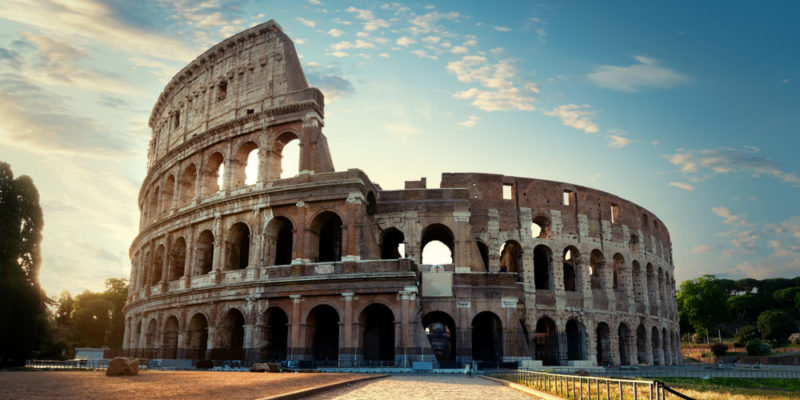
Among the main contributions of the Roman Empire are:
- The development of sophisticated road systemswhich were of great contribution to the expansion of the empire.
- The law systemwhich was the basis of the current legal system.
- The Julian calendarcreated by Julio César in 46 a. C. and that is based on the duration of a solar year.
- The Latinwhich resulted in various languages such as Spanish, French, Italian, Galician, Romanian, Portuguese, among others.
- The division of powersin different political institutions, including the Senate.
- The Roman numbering system.
- Advances in the construction of aqueductswhich allowed to transport fresh water to the city and maintain cleaning.
- Sewers and drainsbased on a sewer system that ran next to the streets and that led to the Tiber River.
- The concrete base for buildings constructionfor example, in the pantheon and the coliseum, which allowed them to stay partially until today.
- Advances in medicine Inherited from the Greeks, to which they added the development of military hospitals and the sanitation system that impacted health.
Continue with:
document.addEventListener(“DOMContentLoaded”, (e) => {
var sliderContainer, slider;
sliderContainer = document.getElementById(‘block_4904d81eb5372140e555aed10e70071f’);
if (typeof initSlider !== ‘function’) {
console.log(‘Swiper haven\’t been loaded’);
sliderContainer.className += ‘ fw scroll-snap’;
return;
};
options = {
direction: ‘horizontal’,
speed: 1000,
slidesPerView: ‘auto’,
// slidesPerGroup: 1,
centerInsufficientSlides: true,
// centeredSlides:true,
spaceBetween: 15,
breakpoints: {
720: {
// centeredSlides: false,
// slidesPerGroup: 2,
spaceBetween: 25
},
},
pagination: {
el: ‘.swiper-pagination’,
type: ‘bullets’,
clickable: true
},
}
slider = initSlider(sliderContainer, options);
})
References
- Bravo, G. (1998). Imperial Rome. History of ancient Rome. Alliance.
- Garnsey, P. and Saller, R. (1991): The Roman Empire. Economy, Society and Culture. Critical ed.
- “The Roman Empire” at https://www.khanacademy.org/
- “Roman Empire (27 BC – 476 ad)” at https://www.rome.net/
- “What are subject characteristics of the Roman Empire?” At https://www.enotes.com/
- “Roman Empire” at https://www.britannica.com/
- “List of rulers of the Roman Empire” at https://www.metmuseum.org/
- “Roman Dynasties” at https://imperiumROMANUM.PL/


